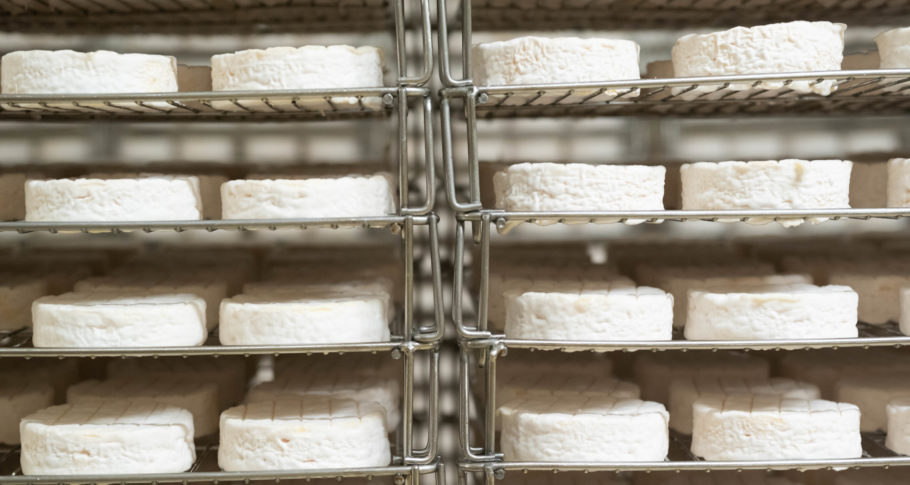1180
Appearance of the word "fromage" ("cheese") in the French dictionary
1200
different French cheeses
60 grammes
... at 60 kilos!
45 PDO cheeses
9 IGP (Protected Geographical Indication) cheeses
“Camembert, Brie, Comté, Beaufort, Roquefort, etc. – these are names that evoke France’s cheese heritage. The diversity of the cheese on offer is the result of a dairy tradition linked to the French regions, to the people and their know-how. Producers have been able to take full advantage of the evolution of technologies to offer more than 1200 cheeses today.
Cheese is the oldest method of preserving milk, it has been consumed for more than 6000 years. There are cheeses made from cow’s, goat’s and sheep’s milk…..and buffalo, camel and yak in other countries around the world. “
The manufacturing steps
Production goes through six stages:
- Milk curdling (or coagulation): coagulating enzymes and lactic ferments are added to the milk. They allow it to coagulate by forming a curd. The respective action of enzymes, ferments, temperature and time define the texture of the cheese.
- Brewing, pressing and heating: all these steps make it possible to eliminate the aqueous part of the curd to make it more concentrated and even more firm.
- Slicing: this step separates the curd from the whey. By stirring, pressing and/or heating, we will obtain cheeses that are more or less firm.
- Moulding/Draining: the curd is placed in a perforated mould which allows it to drain. It is transferred from the vat to a mould which will give the cheese its shape and size.
- Salting: Salting is an essential step in the production of cheese. Salt plays a decisive role in the development of microorganisms. It improves draining and thus contributes to the texture of the cheese. Salting can be done dry by powdering or rubbing, or in brine (i.e. by immersion in salted water) for a certain length of time depending on the size and composition of the cheese.
- Maturing: this is the maturing period during which the original milk components (proteins, fats and lactose) are processed. The taste and fragrance develop under the action of different microorganisms (bacteria, yeasts and moulds) that are naturally present or added. The cheeses are subject to constant care: monitoring the temperature and humidity of the maturing cellars, turning and sometimes brushing. The maturing period can range from twelve days to several months.
- Packaging: This preserves the cheese until it arrives on the consumer’s plate, and it displays legal information.
Throughout this manufacturing process, the cheese undergoes numerous quality and health safety controls.
Microorganisms and cheeses
Cheese production is largely based on the biological activity of micro-organisms. These are controlled and healthy bacteria, yeasts and moulds. Some of them act at the beginning of the transformation process; others intervene during the maturing process. They are at the origin of the taste and texture of cheeses.
The best known are Penicillium camembertii for the white down on the surface of Camembert cheese, Penicillium roquefortii inside blue cheeses such as Roquefort, or Brevibacterium linens, a bacteria that gives Livarot or Munster their orange colour.
Cheeses for all tastes!
- Fresh cheeses: These are cheeses that are slightly drained or not drained, unsalted and unripened.
- Soft cheese with flowery rind: These are the great classics of the French cheese platter. France is the world’s leading producer of soft cheese. In this category, we find flowery rind that has a very fine white down that develops in two to four weeks of ripening. Camembert, Brie, Coulommiers, Chaource and the double and triple creams like Brillat Savarin, are part of this family. It is a soft, tender and mellow cheese.
- Soft cheese with washed rind: these soft cheeses are regularly washed with salted water on the surface and brushed to obtain a crust with a soft and more or less humid appearance. Its colour varies from orange-yellow to brown while the cheese has an ivory tone. Livarot, Epoisses, Munster, Maroilles and Langres are part of this family.
- Blue-veined cheeses: These are also called “blue” cheeses. They are soft cheeses that contain moulds inside the cheese. They take longer to mature than soft cheeses. Roquefort is part of this family. It is made from sheep’s milk. Its cousins made of cow’s milk include the Bleu d’Auvergne, the Fourme d’Ambert, the Fourme de Montbrison and the Bleu de Gex.
- Pressed cheese: Pressed cheeses are soft cheeses with a hard rind. They are classified internationally as hard or semi-hard cheeses. They are called pressed cheese because they undergo high draining during their manufacture under the effect of a press that helps to form a more compact and dense cheese. In this category we find Cantal, Tomes, Reblochon and Saint-Paulin. The shape and weight of these cheeses vary greatly, from 200g to 45kg for Cantal.
- Cooked pressed cheese: the curd for cooked pressed cheese is heated to about 50°C. Cooking the curd allows additional water removal to obtain a dense texture. These are generally large-form cheeses that will be pressed to further improve draining. Internationally, cooked pressed cheese is classified in the category of hard cheeses. Emmental, Comté and Beaufort are part of this family.
- Processed cheeses: Processed cheeses are obtained by cooking one or more cooked or uncooked cheeses in the presence of processing salts. These are used to obtain a homogeneous texture. Cream, butter and casein are added too and they can also be flavoured. They are available in triangular form, in small cubes, slices or jars. The name “cream of…” also refers to processed cheeses. These types of cheese, by virtue of their manufacturing method and composition, can be stored at room temperature.

